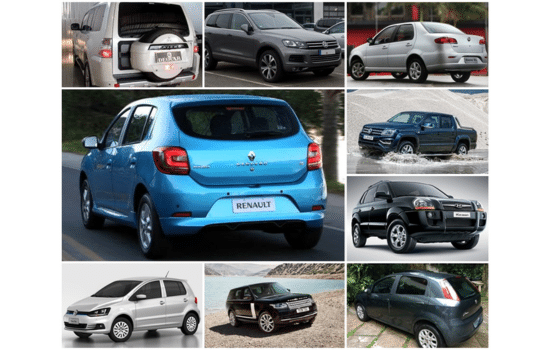Advertisements
Introduction: Why consider fuel consumption?
Fuel consumption is a key factor when choosing a car. It not only affects the daily budget, but also has an environmental impact. Some popular models, despite their advantages, are noted for being less efficient, especially on urban journeys.
If you are thinking about buying a car, knowing which models consume the most fuel can help you make an informed decision. Below, we analyze the 6 popular cars that consume the most fuel, highlighting its characteristics and the reasons behind its high consumption.
Advertisements
Jeep Renegade 1.8 Flex
He Jeep Renegade 1.8 Flex It is one of the best-selling compact SUVs, known for its robust design and advanced technology. However, its fuel consumption places it among the least efficient.
General characteristics
With a 1.8-litre engine, the Renegade prioritises performance over efficiency. Its weight, which exceeds 1,500 kg, also contributes to its high fuel consumption.
Advertisements
Fuel consumption
- City: 6.9 km/l (ethanol) and 10 km/l (gasoline).
- Highway: 8.6 km/l (ethanol) and 12 km/l (gasoline).
Why does he consume so much?
The vehicle's weight and limited aerodynamics make it less efficient in urban environments. In addition, its large engine requires more energy to deliver the expected performance. Despite this, the Renegade remains one of the favourite SUVs for its comfort, design and robustness.
See also:
- The most affordable cars of 2024
- Watch free movies with these apps
- Create amazing videos with photos for free
- Discover your future with free apps
- Listen to music offline without spending money
Fiat Toro 1.8 Flex
The Fiat Toro 1.8 Flex It is a versatile and stylish pickup truck, designed to offer comfort and functionality. However, its high fuel consumption is a drawback for many drivers.
General characteristics
With a robust design and excellent loading capacity, the Toro stands out for its practicality. However, its 1.8 flex engine lacks efficiency compared to current standards.
Fuel consumption
- City: 6.5 km/l (ethanol) and 9.3 km/l (gasoline).
- Highway: 8.4 km/l (ethanol) and 11.2 km/l (gasoline).
Why does he consume so much?
Its solid structure and high weight contribute to high fuel consumption. Its engine is designed for performance, not economy.
Despite this, the Toro remains one of the most popular pickup trucks due to its spaciousness and attractive design.
Chevrolet Spin 1.8
He Chevrolet Spin 1.8 It is very popular with families and shuttle services due to its capacity for up to 7 passengers. However, its high consumption can be a financial concern.
General characteristics
With a spacious interior and a 1.8 flex engine, the Spin is ideal for family trips or passenger transport. However, its powertrain technology is not efficient in terms of fuel economy.
Fuel consumption
- City: 7.2 km/l (ethanol) and 10.1 km/l (gasoline).
- Highway: 8.1 km/l (ethanol) and 12 km/l (gasoline).
Why does he consume so much?
The heavy design, aimed at providing comfort and space, increases fuel consumption. In addition, its reliable but outdated engine does not compare with current technologies.
Despite these limitations, the Spin is widely used for its versatility and functionality.
Volkswagen Amarok V6
The Volkswagen Amarok V6 It is a high-performance pickup truck, ideal for those looking for power and load capacity. However, its V6 engine is a determining factor in its high consumption.
General characteristics
Equipped with a 3.0-litre V6 diesel engine, the Amarok combines power with sophistication. Its robust design makes it perfect for difficult terrain and heavy work.
Fuel consumption
- City: 8.2 km/l (diesel).
- Highway: 10.5 km/l (diesel).
Why does he consume so much?
The powerful engine and high weight contribute to high fuel consumption. However, it is an excellent choice for those looking for reliability in extreme conditions.
Toyota Hilux 2.7 Flex
The Toyota Hilux 2.7 Flex It is known for its durability and performance on difficult terrain, but its high consumption is a disadvantage for daily use.
General characteristics
Powered by a 2.7-litre flexi engine, the Hilux combines power with versatility. It is designed to withstand heavy loads and harsh conditions.
Fuel consumption
- City: 5.9 km/l (ethanol) and 8.5 km/l (gasoline).
- Highway: 7.5 km/l (ethanol) and 10.2 km/l (gasoline).
Why does he consume so much?
The high weight and powerful engine are the main reasons for its high consumption. However, its robustness makes it a reliable option.
Mitsubishi Pajero Sport 3.0
He Mitsubishi Pajero Sport 3.0 It is an SUV designed for adventures, with a focus on strength and durability. Although its performance is outstanding, its consumption is significant.
General characteristics
Equipped with a 3.0-litre V6 engine, the Pajero Sport is perfect for rough terrain and off-road adventures. Its traction capacity and power are some of its biggest draws.
Fuel consumption
- City: 6.1 km/l (gasoline).
- Highway: 8.3 km/l (gasoline).
Why does he consume so much?
The V6 engine and robust design, intended for off-road use, make it less efficient on urban routes or long trips.
How to Reduce Fuel Consumption?
Even with vehicles known for their high consumption, it is possible to adopt practices that optimize fuel use:
- Regular maintenance: Check filters, oil and tires frequently.
- Drive smoothly: Avoid sudden acceleration and braking.
- Calibrate the tires: Underinflated tires increase drag and fuel consumption.
- Plan routes: Choose routes with less congestion.
- Reduces vehicle weight: Remove unnecessary objects that increase the load.
These practices not only save money, but also extend the life of the vehicle.

Conclusion: Evaluate your Priorities
Featured models – Jeep Renegade, Fiat Toro, Chevrolet Spin, Volkswagen Amarok, Toyota Hilux and Mitsubishi Pajero Sport – They are popular for their specific attributes, but share high consumption as a common characteristic.
If saving is your priority, consider other options or adopt practices that minimize the impact of consumption.
However, if performance, space and robustness are essential, these models will still be attractive choices, as long as they are accompanied by proper planning.




